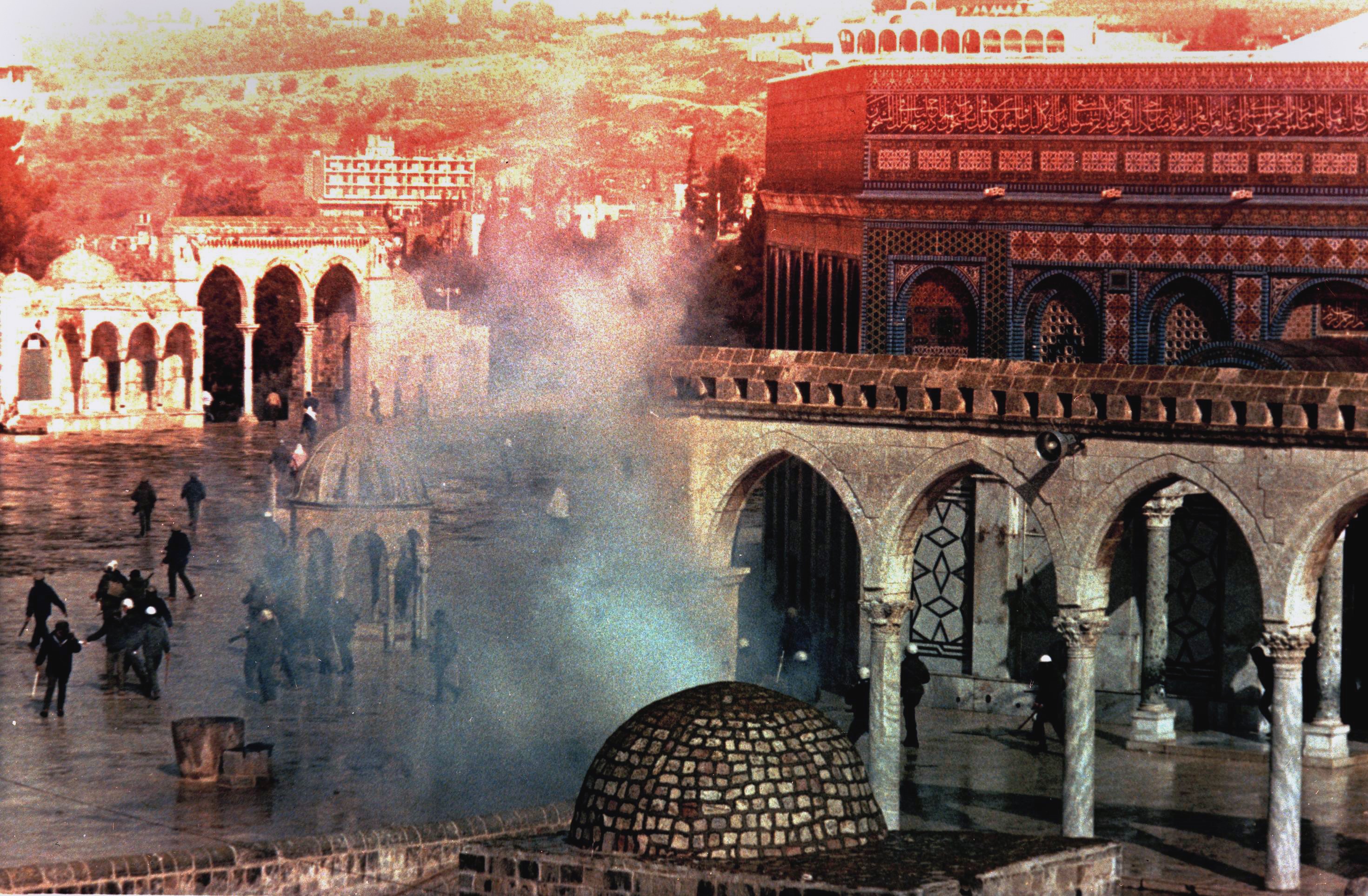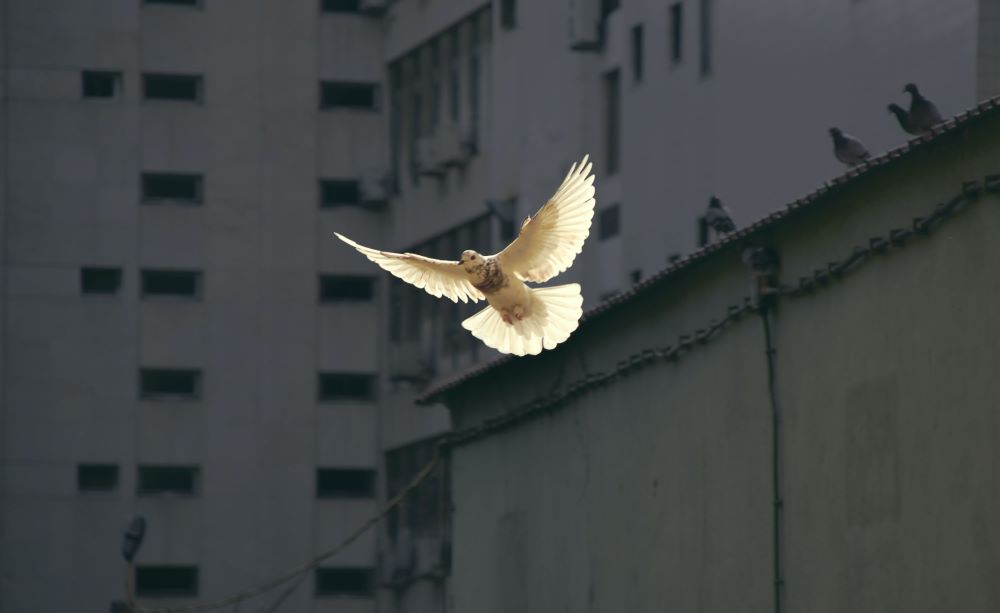
A cloud of tear gas rises from the square in front of the Dome of the Rock mosque during clashes between Palestinians and Israeli troops, which started after the Friday noon prayers on the Temple Mount in the old city of Jerusalem Jan. 15, 1988. (AP/Anat Givon)
We are praying with all our being for Israel in this time of horrific suffering. The massacre Hamas inflicted on Israelis on Oct. 7 was brutal, bringing to mind the worst of history's many crimes against the Jewish people.
As we think about what comes next in the light of our faith we have two prayers. The first is that — after Hamas has been removed from power, and an assessment of why Israel's intelligence agencies did not keep the country safe — they will turn to a different approach. As many in Israel have said: "Israel will never be secure unless they give the Palestinians hope."
Our second prayer is more than a prayer. It is a hope — based on past, historical fact. Our hope is that the Palestinians will give the first intifada, 1987-1993, which was nonviolent, another try.
The first intifada was very well supported by the Palestinian people. Hamas was outside the leadership group looking in. It was led by Mubarak Awad, a Palestinian American clinical psychologist who had intensely studied the life of Abdul Gaffar Khan, the Muslim Pathan from India's Northwest Territories who was the greatest and strongest of Gandhi's colleagues in the fight against the British. Khan led the Khudai Kitmagars, a Pathan youth group, 100,000 strong, dedicated to nonviolent resistance against the British and peacefully serving the Pathan people.
Awad had translated major works on nonviolence into Arabic. He knew that the Palestinians had been the losers during the years of terrorism and believed that violence would only produce more failure. But the alternative to violence was not submission. Just as Gandhi before him believed that the Indian people were under the boot heel of the British because they let them, Awad believed that "to be under occupation is because we permit it. We have to resist. But with nonviolent action."
The earliest stages of the campaign were improvised. The approach to organizing was through distribution of leaflets describing the next steps of action to be taken. The name of the sponsoring organization was the Unified National Command, a coalition of mostly young people with a number of different affiliations. The leaflets were distributed every few weeks by young volunteers who would pick them up from an intermediary and wait until the time seemed right to distribute them in their community. For example, the third numbered leaflet hit the streets and enjoined workers to halt the wheels of industry in Israel.
A detailed plan gradually unfolded, including a revival of traditional Palestinian cultural insignia such as theater, poetry and clothing and obstructive moves such as targeted strikes, boycotts of key Israeli products, withholding tax payments, refusing to produce identity cards and ostracizing collaborators.
The intifada, which meant "shaking off" one's laziness, also concentrated on building a network of popular committees to address an array of community needs and build self-reliance among the people. For example, over the course of the year, several hundred mobile health clinics were up and running.

(Unsplash/Sunguk Kim)
It is estimated that the economic damage for Israel was well over a billion dollars in profits in 1988, from lost taxes, lost low-cost labor and declines in sales.
Some Israeli soldiers, in the face of nonviolent action, decided not to continue military action. Close to 3,000 military reservists, who called themselves Yesh Gvul, refused to serve in the territories, and 160 were arrested. The Israeli government, however, refused to pull back. It expelled leaders of the intifada, including Mubarak Awad, who had long been a polarizing figure in Israel. That meant that Palestinian leadership reverted to the old-time leaders who had little confidence in or experience with leading a nonviolent campaign. Deaths and casualties increased. The second intifada campaign, launched in 2000, reverted to the same old reliance on guns and terror.
Why hope for a renewed nonviolent campaign now? There is an opportunity to correct the mistakes of the first version. First, it has been proven that an effective, nonviolent campaign should be prepared through extensive education and training, including commitments to strict adherence to nonviolence. A culture as inured to violence as the Arab culture (or the U.S.') takes a while to make the adjustment. The followers of Ghaffar Khan, the Pathans, a culture deeply involved with revenge and frightening violence, showed, however, it can be done.
The leaflets of the first intifada recommended 27 methods of struggle, 26 of which were nonviolent. Permitted, however, were some types of violence such as throwing rocks or Molotov cocktails. They were forms of violence they thought were intended to intimidate or aggravate without causing great bodily harm. But that was a departure from classic nonviolent campaigns. And the media in Israel focused on those images of stone throwing, depicting the campaign as violent.
That was unlike the 1963 Children's Crusade of Montgomery, Alabama, for example which showed on television children being attacked by Bull Connor's dogs and being blasted by his water cannons, revealing to the nation — graphically — just how savage Jim Crow in the South really was. The component of Gandhi's satyagraha theory, tapasya or self-suffering, was hardly brought forward by media images in the intifada campaign.

(Unsplash/Markus Spiske)
Furthermore, the campaign was unable to stir up support beyond Israel's boundaries. The nonviolent campaign in South Africa, on the other hand, going on at the same time, succeeded in triggering a worldwide effort to boycott South African goods. Such attempts in the United Nations to vote to condemn the Israeli government's treatment of Palestinians were greeted with some accusations of antisemitism and were blocked. Perhaps the international community has learned that an opportunity was lost back then and would be ready to support a nonviolent Palestinian campaign for freedom this time around.
At the beginning of this essay we indicated that we were thinking about Israel's future in the light of our faith, which is our Catholic faith. We Catholics, in recent years, are gradually being exposed to and taught Jesus' deep commitment to nonviolence. He taught in the Sermon on the Mount: "You have heard it said: 'an eye for an eye, and a tooth for a tooth;' But I say to you: do not return violence for violence." Jesus first points out the traditional teaching is precisely what gets us into horrific cycles of violence. An eye for an eye, as Martin Luther King said, will leave the whole world blind — and a tooth for a tooth, he may have added, will leave the whole world toothless as well.
Gandhi himself said that Jesus was a supreme satyagrahi, history's greatest practitioner of nonviolence. Gandhi read the Sermon on the Mount when he was studying for the bar in England at age 19 and was bowled over by its truth. He had it read to his ashram weekly for the rest of his life.
Advertisement
It has been enlightening to hear one pope after another in recent years embrace the power of nonviolence. Pope John Paul II, for example, wrote that, in his time, during the struggle in Poland to achieve solidarity, he thought the world seemed to be headed for a third world war. He wrote:
It seemed that the European order resulting from the Second World War … could only be overturned by another war. Instead, it has been overcome by the non-violent commitment of people who, while always refusing to yield to the force of power, succeeded time after time in finding effective ways of bearing witness to the truth.
We can hope that just as the people of Eastern Europe freed themselves through nonviolence, the Palestinian people, who once came close, will try it again, and with the support of the international community, succeed.





